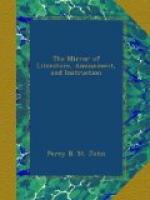“Snatch’d from an Indian ocean’s
roar,
I drink the whelming tide no more;
But in this rock, remote and still,
Now serve to pour the murmuring rill.
Listen! Do thoughts awake, which
long have slept—
Oh! like his song, who placed me here,
The sweetest song to Memory dear,
When life’s tumultuous storms are
past,
May we, to such sweet music, close at
last
The eyelids that have wept!”
Leaving the small oratory, a terrace of flowers leads to a Gothic stone-seat at the end, and, returning to the flower-garden, we wind up a narrow path from the more verdant scene, to a small dark path, with fantastic roots shooting from the bank, where a grave-stone appears, on which an hour-glass is carved.
A root-house fronts us, with dark boughs branching over it. Sit down in that old carved chair. If I cannot welcome some illustrious visitors in such consummate verse as Pope, I may, I hope, not without blameless pride, tell you, reader, in this chair have sat some public characters, distinguished by far more noble qualities than “the nobly pensive St. John!” I might add, that this seat has received, among other visiters, Sir Samuel Romilly, Sir George Beaumont, Sir Humphry Davy—poets as well as philosophers, Madame de Stael, Dugald Stewart, and Christopher North, Esq.
Two lines on a small board on this root-house point the application:—
“Dost thou lament the dead, and
mourn the loss
Of many friends, oh! think upon the cross!”
Over an old tomb-stone, through an arch, at a distance in light beyond, there is a vista to a stone cross, which, in the seventeenth century, would have been idolatrous!
To detail more of the garden would appear ostentatious, and I fear I may be thought egotistical in detailing so much. I shall, however, take the reader, before we part, through an arch, to an old yew, which has seen the persecution of the loyal English clergy; has witnessed their return, and many changes of ecclesiastical and national fortune. Under the branches of that solitary but mute historian of the pensive plain, let us now rest; it stands at the very extreme northern edge of that garden which we have just perambulated. It fronts the tower, the churchyard, and looks on to an old sun-dial, once a cross. The cross was found broken at its foot, probably by the country iconoclasts of the day. I have brought the interesting fragment again into light, and placed it conspicuously opposite to an old Scotch fir in the churchyard, which I think it not unlikely was planted by Townson on his restoration. The accumulation of the soil of centuries had covered an ascent of four steps at the bottom of this record of silent hours. These steps have been worn in places, from the act of frequent prostration or kneeling, by the forefathers of the hamlet, perhaps before the church existed. From a seat near this old yew tree, you see the churchyard, and battlements of the church, on one side; and on the other you look over a great extent of country. On a still summer’s evening, the distant sound of the hurrying coaches, on the great London road, are heard as they pass to and from the metropolis. On this spot this last admonitory inscription fronts you:—




